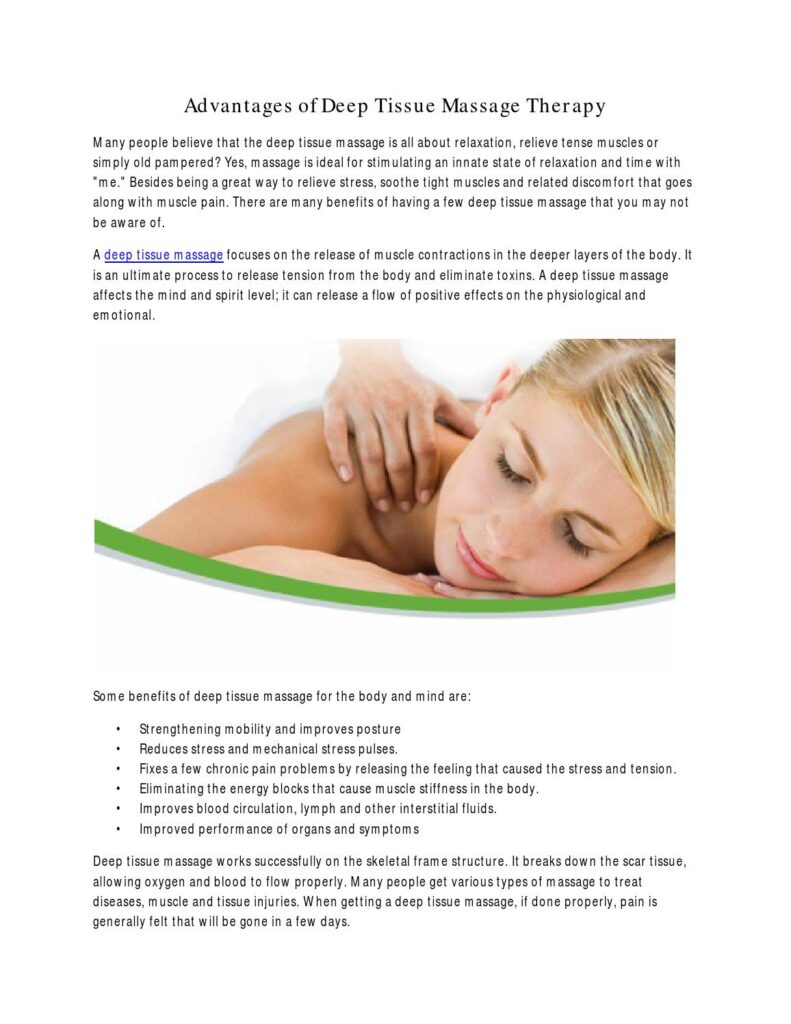Have you ever wondered what causes emotional release during a massage? It’s such an interesting phenomenon, isn’t it? Well, in our article, we delve into the various factors that can contribute to this emotional release. Whether it’s the release of stored emotions or the relaxation of the body and mind, there are several reasons why you may experience a range of emotions during a massage. So, if you’re curious to learn more about this fascinating topic, make sure to check out our article.
In our article, we’ll explore the connection between the body and mind during a massage and how certain techniques can trigger emotional release. We’ll also discuss the importance of a safe and comfortable environment in facilitating this process. Additionally, we’ll touch upon the benefits of emotional release during a massage and how it can contribute to overall well-being. So, if you’re interested in discovering more about what causes emotional release during a massage, be sure to give our article a read. You might even gain some valuable insights to enhance your own massage experiences.

This image is property of surgicalalternative.com.
Understanding Emotional Release
Definition of Emotional Release
Emotional release refers to the experience of letting go of built-up emotions and tension during a massage session. It can manifest as crying, laughter, anger, or a sense of relief. This release is an essential aspect of the mind-body connection and can significantly impact one’s overall well-being.
Importance of Emotional Release in Massage
Emotional release is an integral part of the massage process as it allows for the release of stuck energy and emotional trauma held within the body. While massage primarily focuses on addressing physical pain and tension, it also affects the emotional well-being of an individual. Emotional release during a massage session can provide profound healing at a holistic level.
Connection between Physical and Emotional Well-being
The mind and body are intricately connected, and one’s emotional state can have a direct impact on their physical well-being. Emotional stress and trauma can manifest as physical pain or discomfort. Conversely, physical pain can negatively affect one’s emotional state. Massage, with its ability to address both physical and emotional aspects, serves as a catalyst for healing and well-being.
Factors Contributing to Emotional Release
Release of Endorphins
During a massage, the body releases endorphins, which are natural pain relievers and mood elevators. These feel-good hormones can create a sense of relaxation, happiness, and emotional release. The release of endorphins during a massage can help individuals feel more positive and emotionally balanced.
Relaxation Response
Massage induces the relaxation response in the body, which activates the parasympathetic nervous system. This response counteracts the stress response and promotes a deep sense of calm and relaxation. When the body feels safe and at ease, it is more likely to release held emotions and tension.
Unblocking Energy Pathways
In traditions such as Traditional Chinese Medicine, it is believed that emotional trauma and stress can cause blockages in the body’s energy pathways, known as meridians. Massage, especially techniques like acupressure and reflexology, can help to release these blockages and restore the smooth flow of energy. This release of blockages can lead to emotional release as well.
Releasing Stored Trauma
Emotional trauma can become stored in the body at a cellular level. These stored emotions can manifest as physical pain or discomfort. Massage, particularly techniques like myofascial release and craniosacral therapy, can help release these stored emotions, allowing for emotional release and relief from physical symptoms.
Stimulating the Lymphatic System
The lymphatic system plays a crucial role in the body’s detoxification process. By stimulating lymphatic flow through massage, toxins and metabolic waste products can be efficiently eliminated from the body. This detoxification process can create a sense of lightness and release, both physically and emotionally.
Impact of Touch and Human Connection
Power of Human Touch
Human touch has a profound impact on our physical and emotional well-being. Touch releases oxytocin, the hormone responsible for feelings of love, trust, and bonding. The power of touch extends beyond physical sensation; it conveys care, compassion, and human connection. During a massage, the nurturing touch provided by the therapist promotes a sense of safety and allows for emotional release.
Release of Oxytocin
The release of oxytocin during massage not only promotes a sense of relaxation but also enhances emotional connection. Oxytocin has been shown to reduce anxiety and increase feelings of contentment. It helps individuals feel more connected to their own emotions and those of others, allowing for a deeper emotional release during a massage session.
Enhancing Emotional Connection
Through touch and empathetic presence, massage therapists can create a safe space for emotional release. By fostering a sense of trust and open communication, clients can feel comfortable expressing and releasing their emotions. This emotional connection facilitates the release of built-up tension and promotes overall emotional well-being.
Therapeutic Techniques and Emotional Release
Massage therapists utilize various techniques to promote emotional release during a session. Some of these techniques include:
Deep Tissue Massage
Deep tissue massage targets the deeper layers of muscle and connective tissues, working to release chronic tension and knots. By applying firm pressure, deep tissue massage can trigger emotional release, as stored emotions may be released along with physical tension.
Trigger Point Therapy
Trigger points are areas of muscle that are highly sensitive due to muscle knots or taut bands. Trigger point therapy addresses these points to release muscle tension. During this therapy, clients may experience emotional release as the release of trigger points is often accompanied by the release of trapped emotions.
Myofascial Release
Myofascial release is a technique that targets the body’s fascia, the connective tissue that surrounds muscles and organs. It involves gentle stretching and sustained pressure to release restrictions and promote emotional and physical release.
Craniosacral Therapy
Craniosacral therapy focuses on the craniosacral system, which includes the bones, tissues, and fluids surrounding the brain and spinal cord. By gently manipulating the craniosacral system, this therapy aims to release emotional and physical tension, facilitating emotional release.
Reflexology
Reflexology is a technique that applies pressure to specific points on the hands, feet, and ears corresponding to different organs and systems of the body. By stimulating these reflex points, emotional blockages can be released, promoting a sense of balance and emotional well-being.

This image is property of static.wixstatic.com.
Psychological and Emotional Responses
Catharsis and Release of Tension
Emotional release during massage can be experienced as a catharsis, a purging or release of emotional tension. This release of emotional energy can bring about a sense of relief, lightness, and even profound emotional insight.
Emotional Release as a Release of Suppressed Emotions
Massage can act as a safe space for individuals to express and release suppressed emotions. The physical and emotional relaxation experienced during a massage session can create an opening for these emotions to surface and be acknowledged, leading to their release.
Resolving Past Emotional Trauma
Emotional release during massage can also serve as a catalyst for healing past emotional trauma. By releasing held emotions, individuals can gain a new perspective on their experiences and find closure or resolution. This release allows for emotional growth and healing.
Individual Variations in Emotional Release
Personality and Emotional Vulnerability
Each individual responds differently to emotional release during a massage session due to their unique personality and emotional vulnerability. Some individuals may find it easier to release emotions, while others may require more time and trust to feel comfortable. Massage therapists should be sensitive to these individual variations and adapt their approach accordingly.
Current Emotional State
The emotional release experienced during a massage session can also be influenced by an individual’s current emotional state. Clients who are already feeling emotionally overwhelmed or distressed may experience a more intense release compared to those who are in a relatively stable emotional state.
Client-Therapist Relationship
The quality of the client-therapist relationship plays a significant role in facilitating emotional release. Trust, empathy, and open communication are essential in creating a safe and supportive environment for emotional release to occur. A strong therapeutic relationship can help clients feel more comfortable expressing and processing their emotions.

This image is property of luminamassage.com.
Emotional Release Techniques and Consent
Ensuring Client Comfort
Prioritizing client comfort is crucial when it comes to emotional release during a massage session. Massage therapists should create a safe and soothing environment that promotes relaxation and trust. This includes providing appropriate draping, maintaining professional boundaries, and addressing any concerns or discomfort the client may have.
Creating a Safe and Supportive Environment
Massage therapists should strive to create an emotionally safe and supportive environment. They can achieve this by actively listening to their clients’ needs and concerns, demonstrating empathy, and maintaining confidentiality. Clients should feel comfortable expressing their emotions without judgment or criticism.
Communication and Consent
Clear and open communication is essential in the context of emotional release during a massage session. Massage therapists should discuss the possibility of emotional release with their clients before the session, ensuring that they are aware of the potential for intense feelings to arise. Clients should have the opportunity to give their consent and discuss any boundaries or concerns they may have.
Post-Massage Emotional Well-being
Integration and Processing
After experiencing emotional release during a massage session, it is important for individuals to take time to integrate and process their emotions. This can involve journaling, talking with a trusted friend or therapist, or engaging in self-reflection. Allowing oneself to fully experience and acknowledge the emotions released during the massage can lead to continued emotional growth and healing.
Self-Care Strategies
Engaging in self-care practices is vital to support emotional well-being after a massage session. This can include activities such as taking a relaxing bath, practicing mindfulness or meditation, engaging in creative outlets, or engaging in activities that bring joy. Self-care enables individuals to nurture their emotional needs and maintain the positive effects of emotional release.
Long-Term Emotional Benefits
Regular massage therapy, with its potential for emotional release, can have long-term emotional benefits. By consistently addressing and releasing emotional tension, individuals can experience improved emotional well-being, increased resilience, and enhanced self-awareness. Massage therapy can become an integral part of one’s overall self-care routine for emotional balance and well-being.

This image is property of i0.wp.com.
Supporting Clients through Emotional Release
Active Listening and Empathy
Massage therapists can provide support during emotional release by actively listening to their clients and demonstrating empathy. Being fully present and acknowledging the client’s emotions without judgment allows for a deeper emotional connection and helps the client feel heard and understood.
Providing Emotional Support
Massage therapists can provide emotional support to clients by validating their emotions and offering appropriate words of reassurance and encouragement. This support can include gentle reminders that emotional release is a normal and beneficial part of the healing process.
Referral to Mental Health Professionals
In some cases, emotional release during massage may bring up unresolved or complex emotional issues that require further professional intervention. Massage therapists should be aware of their scope of practice and, if necessary, refer clients to mental health professionals who can provide specialized support and guidance.
Conclusion
Emotional release is a natural and beneficial occurrence during a massage session. It allows for the release of built-up emotions, trauma, and tension, promoting emotional well-being and overall healing. By understanding the factors contributing to emotional release, utilizing therapeutic techniques, and providing emotional support, massage therapists can create a safe and nurturing space for clients to experience profound emotional release and growth. So, embrace the potential for emotional release during your next massage session and allow yourself to experience the transformative power of touch and human connection.

This image is property of www.massagemag.com.






